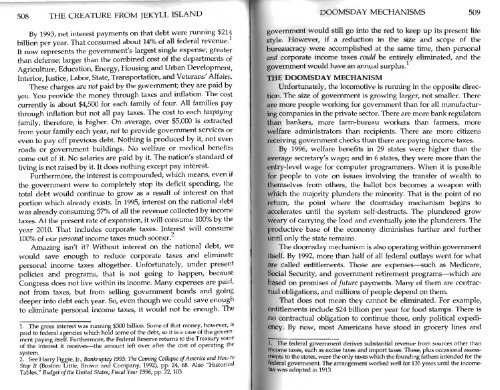Create successful ePaper yourself
Turn your PDF publications into a flip-book with our unique Google optimized e-Paper software.
508 THE CREATURE FROM JEKYLL ISLAND<br />
By 1993, net interest payments on that debt were running $214<br />
billion per year- That consumed about 14% of all federal revenue.<br />
It now represents the government's largest single expense; greater<br />
than defense; larger than the combined cost of the departments of<br />
Agriculture, Education, Energy, Housing and Urban Development,<br />
Interior, Justice, Labor, State, Transportation, and Veterans' Affairs.<br />
These charges are not paid by the government; they are paid by<br />
you. You provide the money through taxes and inflation. The cost<br />
currently is<br />
about $4,500 for each family of four. All families pay<br />
through inflation but not all pay taxes. The cost to each taxpaying<br />
family, therefore, is higher. On average, over $5,000 is extracted<br />
from your family each year, not to provide government services or<br />
even to pay off previous debt. Nothing is produced by it, not even<br />
roads or government buildings. No welfare or medical benefits<br />
come out of it. No salaries are paid by it. The nation's standard of<br />
living is not raised by it. It does nothing except pay interest.<br />
Furthermore, the interest is compounded, which means, even if<br />
the government were to completely stop its<br />
deficit spending, the<br />
total debt would continue to grow as a result of interest on that<br />
portion which already exists. In 1995, interest on the national debt<br />
was already consuming 57% of all the revenue collected by income<br />
taxes. At the present rate of expansion, it will consume 100% by the<br />
year 2010. That includes corporate taxes. Interest will consume<br />
100% of our personal income taxes much sooner.<br />
Amazing isn't it? Without interest on the national debt, we<br />
would save enough to reduce corporate taxes and eliminate<br />
personal income taxes altogether. Unfortunately, under present<br />
policies and programs, that is not going to happen, because<br />
Congress does not live within its income. Many expenses are paid,<br />
not from taxes, but from selling government bonds and going<br />
deeper into debt each year. So, even though we could save enough<br />
to eliminate personal income taxes, it would not be enough. The<br />
1. The gross interest was running $300 billion. Some of that money, however, is<br />
paid to federal agencies which hold some of the debt, so it is a case of the government<br />
paying itself. Furthermore, the Federal Reserve returns to the Treasury some<br />
of the interest it receives—the amount left over after the cost of operating the<br />
system.<br />
2, See Harry Figgie, Jr., Bankruptcy 1995: The Coming Collapse ofAmerica and How to<br />
Stop It (Boston: Little, Brown and Company, 1992), pp. 24, 68. Also "Historical<br />
Tables," Budget oftte United States; Fiscal Year 1996, pp. 22, 103.<br />
DOOMSDAY MECHANISMS 509<br />
government would still go into the red to keep up its present life<br />
style. However, if a reduction in the size and scope of the<br />
bureaucracy were accomplished at the same time, then personal<br />
and corporate income taxes could be entirely eliminated, and the<br />
government would have an annual surplus.<br />
THE DOOMSDAY MECHANISM<br />
Unfortunately, the locomotive is running in the opposite direction.<br />
The size of government is growing larger, not smaller. There<br />
are more people working for government than for all manufacturing<br />
companies in the private sector. There are more bank regulators<br />
than bankers, more farm-bureau workers than farmers, more<br />
welfare administrators than recipients. There are more citizens<br />
receiving government checks than there are paying income taxes.<br />
By 1996, welfare benefits in 29 states were higher than the<br />
average secretary's wage; and in 6 states, they were more than the<br />
entry-level wage for computer programmers. When it is possible<br />
for people to vote on issues involving the transfer of wealth to<br />
themselves from others, the ballot box becomes a weapon with<br />
which the majority plunders the minority. That is the point of no<br />
return, the point where the doomsday mechanism begins to<br />
accelerates until the system self-destructs. The plundered grow<br />
weary of carrying the load and eventually join the plunderers. The<br />
productive base of the economy diminishes further and further<br />
until only the state remains.<br />
The doomsday mechanism is also operating within government<br />
itself. By 1992, more than half of all federal outlays went for what<br />
are called entitlements. Those are expenses—such as Medicare,<br />
Social Security, and government retirement programs—which are<br />
based on promises of future payments. Many of them are contractual<br />
obligations, and millions of people depend on them.<br />
That does not mean they cannot be eliminated. For example,<br />
entitlements include $24 billion per year for food stamps. There is<br />
no contractual obligation to continue those, only political expediency.<br />
By now, most Americans have stood in grocery lines and<br />
J- The federal government derives substantial revenue from sources other than<br />
income taxes, such as excise taxes and import taxes. These, plus occasional assessments<br />
to the states, were the only taxes which the founding fathers intended for the<br />
federal government. The arrangement worked well for 135 years until the incometax<br />
was adopted in 1913.


